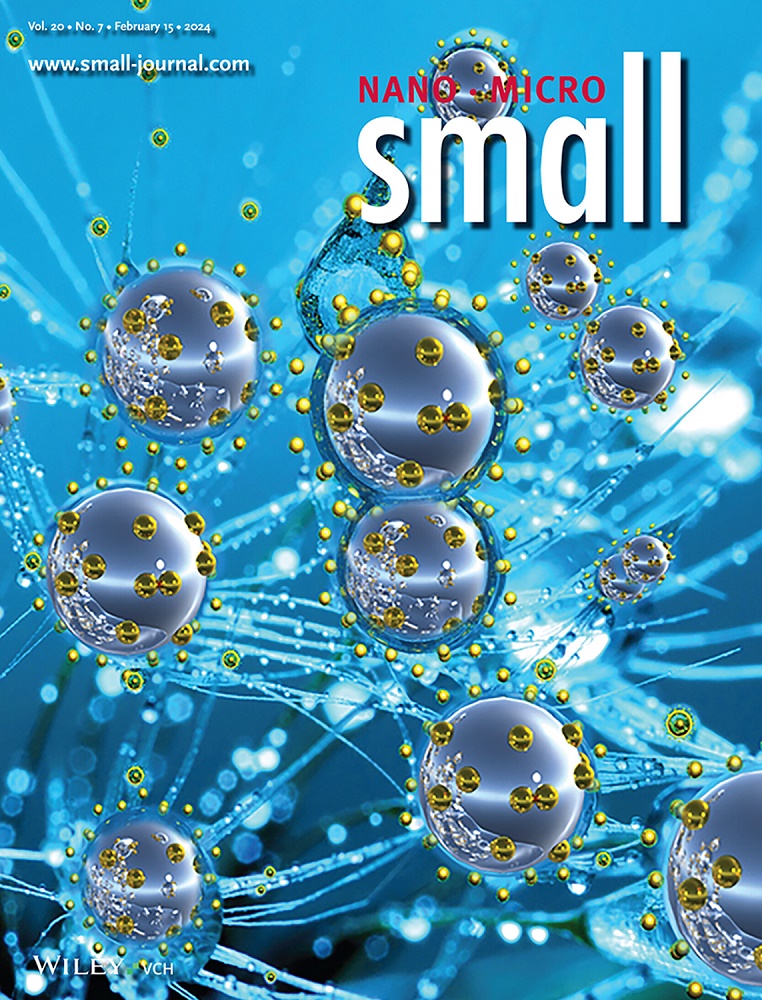Quantum-Confinement-Effect-Tuned Cascade AlQDs/β-Ga₂O₃ Heterojunctions for Ultrasensitive Solar-Blind Photodetection and Interference-Resistant Imaging.
IF 12.1
2区 材料科学
Q1 CHEMISTRY, MULTIDISCIPLINARY
引用次数: 0
Abstract
Solar-blind photodetection plays a crucial role in environmental monitoring, corona detection, and covert battlefield communication due to its unique high signal-to-noise ratios in the UVC band. Aluminum quantum dots (AlQDs) emerge as promising optical materials owing to their extended photoresponse in the ultraviolet region, along with their low cost and compatibility with optoelectronic devices. Herein, an AlQDs-based cascade solar-blind photodetector is presented with enhanced sensitivity, achieved through the quantum confinement effect. By employing a gradient double-layer AlQDs stack integrated with β-Ga₂O₃, the heterojunction demonstrates a significantly suppressed dark current, reduced from 3 nA to 2 pA, and a spectral noise density of 2.8 × 10 -11 A Hz⁻1 / 2 compared to the single-layer device. The optimized photodetector achieves a high UV-vis rejection ratio (R250/R400) of 2.5 × 103, a specific detectivity of ≈2.3 × 101 2 Jones, a relatively fast response time of 25 ms, and a responsivity of 35.1 mA W-1 under a 1 V bias. Furthermore, the device demonstrates robust interference-resistant imaging capabilities, enabling ultra-weak photodetection down to 23 nW cm-2. These results highlight the potential of AlQDs-based cascade devices for advanced solar-blind photodetection applications.用于超灵敏太阳盲光探测和抗干扰成像的量子约束效应调谐级联AlQDs/β-Ga₂O₃异质结。
由于其在UVC波段具有独特的高信噪比,在环境监测、电晕探测和隐蔽战场通信中发挥着至关重要的作用。铝量子点(AlQDs)由于其在紫外区的扩展光响应,以及其低成本和光电子器件的兼容性而成为有前途的光学材料。本文提出了一种基于alqds的级联太阳盲光电探测器,通过量子约束效应实现了灵敏度的提高。通过采用与β-Ga₂O₃集成的梯度双层AlQDs堆叠,与单层器件相比,异质结具有明显的暗电流抑制,从3na降低到2pa,光谱噪声密度为2.8 × 10 -11 a Hz⁻1 / 2。优化后的光电探测器在1 V偏置下具有较高的紫外-可见抑制比(R250/R400)为2.5 × 103,比探测率为≈2.3 × 102jones,相对较快的响应时间为25 ms,响应率为35.1 mA W-1。此外,该器件具有强大的抗干扰成像能力,可实现低至23 nW cm-2的超弱光探测。这些结果突出了基于alqds的级联器件在先进的太阳盲光探测应用中的潜力。
本文章由计算机程序翻译,如有差异,请以英文原文为准。
求助全文
约1分钟内获得全文
求助全文
来源期刊

Small
工程技术-材料科学:综合
CiteScore
17.70
自引率
3.80%
发文量
1830
审稿时长
2.1 months
期刊介绍:
Small serves as an exceptional platform for both experimental and theoretical studies in fundamental and applied interdisciplinary research at the nano- and microscale. The journal offers a compelling mix of peer-reviewed Research Articles, Reviews, Perspectives, and Comments.
With a remarkable 2022 Journal Impact Factor of 13.3 (Journal Citation Reports from Clarivate Analytics, 2023), Small remains among the top multidisciplinary journals, covering a wide range of topics at the interface of materials science, chemistry, physics, engineering, medicine, and biology.
Small's readership includes biochemists, biologists, biomedical scientists, chemists, engineers, information technologists, materials scientists, physicists, and theoreticians alike.
 求助内容:
求助内容: 应助结果提醒方式:
应助结果提醒方式:


